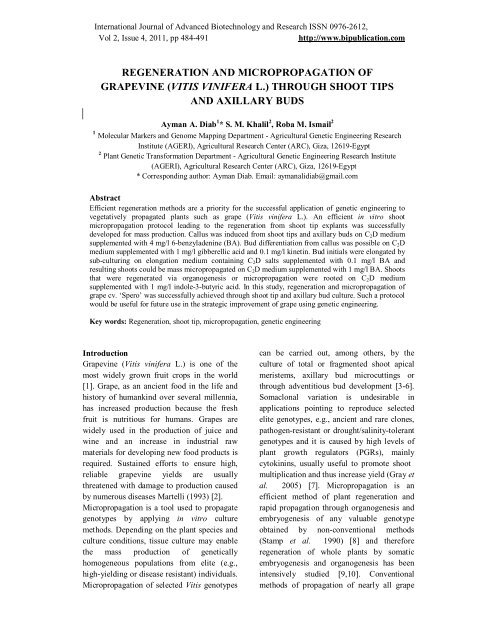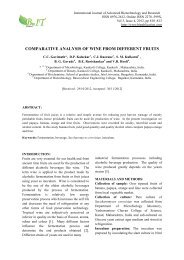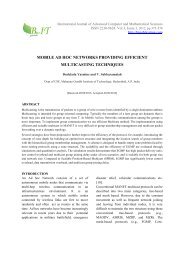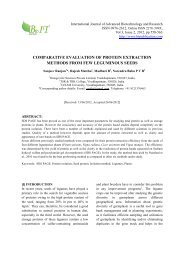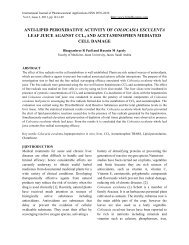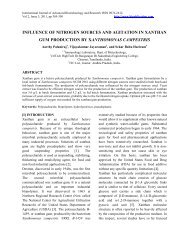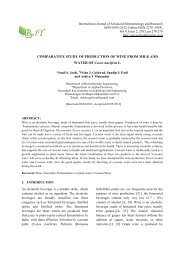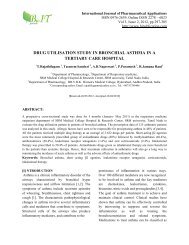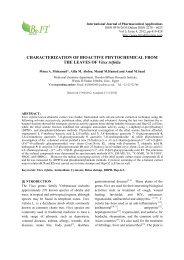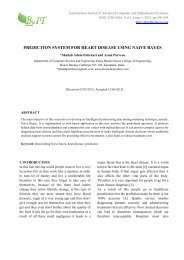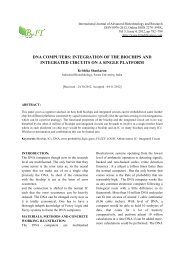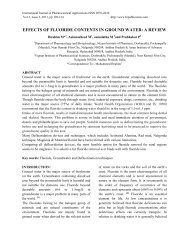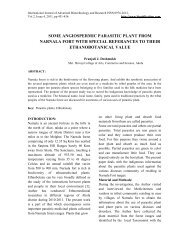regeneration and micropropagation of grapevine - BioIT ...
regeneration and micropropagation of grapevine - BioIT ...
regeneration and micropropagation of grapevine - BioIT ...
Create successful ePaper yourself
Turn your PDF publications into a flip-book with our unique Google optimized e-Paper software.
International Journal <strong>of</strong> Advanced Biotechnology <strong>and</strong> Research ISSN 0976-2612,<br />
Vol 2, Issue 4, 2011, pp 484-491<br />
http://www.bipublication.com<br />
REGENERATION AND MICROPROPAGATION OF<br />
GRAPEVINE (VITIS VINIFERA L.) THROUGH SHOOT TIPS<br />
AND AXILLARY BUDS<br />
Ayman A. Diab 1 * S. M. Khalil 2 , Roba M. Ismail 2<br />
1 Molecular Markers <strong>and</strong> Genome Mapping Department - Agricultural Genetic Engineering Research<br />
Institute (AGERI), Agricultural Research Center (ARC), Giza, 12619-Egypt<br />
2 Plant Genetic Transformation Department - Agricultural Genetic Engineering Research Institute<br />
(AGERI), Agricultural Research Center (ARC), Giza, 12619-Egypt<br />
* Corresponding author: Ayman Diab. Email: aymanalidiab@gmail.com<br />
Abstract<br />
Efficient <strong>regeneration</strong> methods are a priority for the successful application <strong>of</strong> genetic engineering to<br />
vegetatively propagated plants such as grape (Vitis vinifera L.). An efficient in vitro shoot<br />
<strong>micropropagation</strong> protocol leading to the <strong>regeneration</strong> from shoot tip explants was successfully<br />
developed for mass production. Callus was induced from shoot tips <strong>and</strong> axillary buds on C 2 D medium<br />
supplemented with 4 mg/l 6-benzyladenine (BA). Bud differentiation from callus was possible on C 2 D<br />
medium supplemented with 1 mg/l gibberellic acid <strong>and</strong> 0.1 mg/l kinetin. Bud initials were elongated by<br />
sub-culturing on elongation medium containing C 2 D salts supplemented with 0.1 mg/l BA <strong>and</strong><br />
resulting shoots could be mass micropropagated on C 2 D medium supplemented with 1 mg/l BA. Shoots<br />
that were regenerated via organogenesis or <strong>micropropagation</strong> were rooted on C 2 D medium<br />
supplemented with 1 mg/l indole-3-butyric acid. In this study, <strong>regeneration</strong> <strong>and</strong> <strong>micropropagation</strong> <strong>of</strong><br />
grape cv. ‘Spero’ was successfully achieved through shoot tip <strong>and</strong> axillary bud culture. Such a protocol<br />
would be useful for future use in the strategic improvement <strong>of</strong> grape using genetic engineering.<br />
Key words: Regeneration, shoot tip, <strong>micropropagation</strong>, genetic engineering<br />
Introduction<br />
Grapevine (Vitis vinifera L.) is one <strong>of</strong> the<br />
most widely grown fruit crops in the world<br />
[1]. Grape, as an ancient food in the life <strong>and</strong><br />
history <strong>of</strong> humankind over several millennia,<br />
has increased production because the fresh<br />
fruit is nutritious for humans. Grapes are<br />
widely used in the production <strong>of</strong> juice <strong>and</strong><br />
wine <strong>and</strong> an increase in industrial raw<br />
materials for developing new food products is<br />
required. Sustained efforts to ensure high,<br />
reliable <strong>grapevine</strong> yields are usually<br />
threatened with damage to production caused<br />
by numerous diseases Martelli (1993) [2].<br />
Micropropagation is a tool used to propagate<br />
genotypes by applying in vitro culture<br />
methods. Depending on the plant species <strong>and</strong><br />
culture conditions, tissue culture may enable<br />
the mass production <strong>of</strong> genetically<br />
homogeneous populations from elite (e.g.,<br />
high-yielding or disease resistant) individuals.<br />
Micropropagation <strong>of</strong> selected Vitis genotypes<br />
can be carried out, among others, by the<br />
culture <strong>of</strong> total or fragmented shoot apical<br />
meristems, axillary bud microcuttings or<br />
through adventitious bud development [3-6].<br />
Somaclonal variation is undesirable in<br />
applications pointing to reproduce selected<br />
elite genotypes, e.g., ancient <strong>and</strong> rare clones,<br />
pathogen-resistant or drought/salinity-tolerant<br />
genotypes <strong>and</strong> it is caused by high levels <strong>of</strong><br />
plant growth regulators (PGRs), mainly<br />
cytokinins, usually useful to promote shoot<br />
multiplication <strong>and</strong> thus increase yield (Gray et<br />
al. 2005) [7]. Micropropagation is an<br />
efficient method <strong>of</strong> plant <strong>regeneration</strong> <strong>and</strong><br />
rapid propagation through organogenesis <strong>and</strong><br />
embryogenesis <strong>of</strong> any valuable genotype<br />
obtained by non-conventional methods<br />
(Stamp et al. 1990) [8] <strong>and</strong> therefore<br />
<strong>regeneration</strong> <strong>of</strong> whole plants by somatic<br />
embryogenesis <strong>and</strong> organogenesis has been<br />
intensively studied [9,10]. Conventional<br />
methods <strong>of</strong> propagation <strong>of</strong> nearly all grape
REGENERATION AND MICROPROPAGATION OF GRAPEVINE (VITIS VINIFERA L.)<br />
varieties are stem cuttings, layering <strong>and</strong><br />
grafting. Genetic improvement <strong>of</strong> classic<br />
cultivars in order to obtain high quality wine<br />
<strong>and</strong> table grape varieties through conventional<br />
hybridization methods does not appear to be<br />
practical <strong>and</strong> therefore unconventional<br />
approaches have been proposed [8,9,1]. A<br />
prerequisite to develop such approaches for<br />
<strong>grapevine</strong> is the ability to establish efficient in<br />
vitro <strong>regeneration</strong> techniques[1]. Thus, the<br />
objective <strong>of</strong> this study was to establish a<br />
<strong>regeneration</strong> <strong>and</strong> <strong>micropropagation</strong> protocol<br />
for Speryo grape.<br />
MATERIALS AND METHODS<br />
Preparation <strong>and</strong> sterilization <strong>of</strong> plant<br />
material<br />
Speryo, a cultivar <strong>of</strong> <strong>grapevine</strong> <strong>of</strong> highly local<br />
importance in Egypt, was used in this<br />
investigation. Grapevine seedlings <strong>of</strong> 5-10<br />
years old vines were kindly provided from El-<br />
Karma Farm, Mon<strong>of</strong>eya Government. Shoot<br />
tips (0.3-0.5 cm) were used as explants for<br />
<strong>micropropagation</strong> <strong>and</strong>/or <strong>regeneration</strong> through<br />
indirect organogenesis, i.e. via callus<br />
induction. Shoot tips explants were washed<br />
thoroughly for 15 min under running tap<br />
water. For surface sterilization, explants were<br />
dipped in 75% (v/v) ethanol for 1 min,<br />
followed by immersion in 25% (v/v)<br />
commercial bleach (final concentration <strong>of</strong><br />
sodium hypochlorite = 1.5% ) containing<br />
0.1% Tween-20 for 30 min <strong>and</strong> rinsed three<br />
times in sterile, distilled water.<br />
Media composition <strong>and</strong> preparation<br />
Nutritional requirements for optimal growth<br />
<strong>of</strong> a tissue in vitro may vary with the species.<br />
Even tissues from different parts <strong>of</strong> the plant<br />
may have different requirements for<br />
satisfactory growth. There is no single<br />
medium that is suitable for all types <strong>of</strong> plant<br />
tissues <strong>and</strong> organs.<br />
Therefore, three media that represent high,<br />
medium <strong>and</strong> low salt concentrations were<br />
selected for the present investigation.<br />
Murashige <strong>and</strong> Skoog (MS; Murashige <strong>and</strong><br />
Skoog, 1962 [11]), C 2 D Vitis basal medium<br />
[12], <strong>and</strong> WPM medium [13] were used. The<br />
composition <strong>of</strong> three different media is<br />
presented in Table (1).<br />
Table 1 The composition <strong>of</strong> different media used in Vitis<br />
<strong>micropropagation</strong><br />
Compound<br />
Macronutrient<br />
MS<br />
(mg/l)<br />
C2D (mg/l)<br />
NH 4NO 3 1650 1650 400<br />
KNO3 1900 1900 --<br />
MgSO4.7H2O 370 370 180.7<br />
KH2PO4 170 170 170<br />
CaCl2. 2H2O 440 -- 72.5<br />
Ca(NO3).4H2O -- 709 386<br />
FeSO4.7H2O 28 27.8 27.5<br />
Na2.EDTA 37 37.3 37.3<br />
Micronutrient<br />
KI 0.83 -- --<br />
MnSO4.4H2O 22.3 0.845 22.3<br />
H3BO3 6.2 6.2 6.2<br />
ZnSO4.7H2O 8.6 8.6 8.6<br />
Na2MoO4.2H2O 0.25 0.25 0.25<br />
CuSO4.5H2O 0.025 0.025 0.25<br />
CoCl2.6H2O 0.025 0.025 --<br />
K2so4 --- --- 999<br />
WPM (mg/l)<br />
The principal components <strong>of</strong> most tissue<br />
culture media can be categorized into<br />
inorganic nutrients (macro <strong>and</strong> micro),<br />
organic nutrients (vitamins <strong>and</strong> amino acids),<br />
a carbon source, PGRs <strong>and</strong> a gelling agent.<br />
Other undefined organic supplements such as<br />
CH <strong>and</strong> CM were also added to the medium<br />
when required (PhytoTechnology<br />
Laboratories, Inc. www.Phytotechlap.com).<br />
PGRs were purchased from Sigma-Aldrich<br />
(St. Louis, MI, USA). Bacteriological grade<br />
agar was used as the gelling agent throughout<br />
the study.<br />
Different cytokinin (BA, TDZ or kin) with<br />
different concentrations was added to each <strong>of</strong><br />
these media, aimed to study the effect <strong>of</strong> it on<br />
<strong>micropropagation</strong> <strong>and</strong> <strong>regeneration</strong> <strong>of</strong> grape.<br />
While different concentration <strong>of</strong> BA were<br />
used aimed to have no vitrified plantlets.<br />
All media were supplemented with 3% (w/v)<br />
sucrose <strong>and</strong> 0.6% agar (w/v). The cultures<br />
were incubated at 25°C under a 16/8 h<br />
day/night photoperiod (1000-Lux).<br />
Shoot induction <strong>and</strong> <strong>micropropagation</strong><br />
media<br />
Ayman A. Diab, et al.<br />
485
REGENERATION AND MICROPROPAGATION OF GRAPEVINE (VITIS VINIFERA L.)<br />
Sterilized explants were transferred to one <strong>of</strong><br />
three shoot induction medium, i.e., C 2 D, MS<br />
<strong>and</strong> WPM. The C 2 D medium contained salt<br />
with vitamin, 3% (w/v) sucrose, 0.6% (w/v)<br />
agar in addition to BA, or Kin in three<br />
concentrations (1, 2 <strong>and</strong> 4 mg/l for each), or<br />
TDZ in three concentrations (0.1, 0.2 <strong>and</strong> 1<br />
mg/L). The two other media (MS <strong>and</strong> WPM)<br />
were supplemented with BA only at three<br />
concentrations (1, 2 <strong>and</strong> 4 mg/l). Four weeks<br />
later <strong>and</strong> after selecting the best basal<br />
medium, the selected medium was<br />
supplemented with different concentrations <strong>of</strong><br />
auxins for elongation shoots. The shoot<br />
primordia was transferred to medium<br />
supplemented with (BA, GA <strong>and</strong> Kin) at three<br />
different concentrations (0.1, 0.5 or 1 mg/l for<br />
each hormone), each plate contained 20<br />
explants. The plates were sealed with<br />
parafilm <strong>and</strong> incubated at 25°C under a 16-h<br />
photoperiod (1000-Lux).<br />
Grape <strong>regeneration</strong><br />
Thirty two calluses from 60 explants were<br />
induced on C 2 D <strong>and</strong> WPM media<br />
supplemented with 4 mg/l BA or 4mg/l kin.<br />
These calluses were examined on C 2 D basal<br />
medium supplemented with 30 g/l sucrose, 6<br />
g/l agar <strong>and</strong> with two PGRs: NAA <strong>and</strong> BA.<br />
After two weeks from planting on this<br />
medium, calluses were transferred to C 2 D<br />
medium supplemented with 1 mg/l gibrillic<br />
acid GA3 <strong>and</strong> 0.1 mg/l Kin for differentiate.<br />
After 2-4 weeks, differentiated calluses were<br />
transferred to shoot elongation medium.<br />
Organogenesis shoot proliferation cultures<br />
were subjected to light with photoperiod <strong>of</strong> 16<br />
h a day. After another four weeks, the shoots<br />
were transferred to rooting medium<br />
supplemented with (IAA, NAA <strong>and</strong> IBA) at a<br />
concentration <strong>of</strong> 1mg/l for each; roots were<br />
grown after 6 weeks on the rooting media.<br />
The pH <strong>of</strong> all media was adjusted at 5.8 <strong>and</strong><br />
autoclaved at 121°C with 15 psi pressure for<br />
15 min.<br />
Acclimatization<br />
For acclimatization, “In vitro” derived rooted<br />
plantlets were acclimatized under controlled<br />
environment. The pots were covered with a<br />
plastic bag inside greenhouse. The problem <strong>of</strong><br />
phenolic exudation from explants was tackled<br />
by repeated Sub-culturing on fresh media.<br />
The damaged tissues on both explants sides<br />
were aseptically cut <strong>of</strong>f <strong>and</strong> the nodal<br />
segments were immersed base down into<br />
solid culture medium.<br />
Results <strong>and</strong> Discussion<br />
Grape-vine (Vitis vinifera L.) is a perennial<br />
deciduous woody vine which is cultivated all<br />
over the world. The conventional method <strong>of</strong><br />
grape vine propagation is time consuming <strong>and</strong><br />
allows diseases transmission. A planted<br />
<strong>grapevine</strong> needs four to five years to produce<br />
propagation materials by cuttings. By using<br />
the tissue culture technique, a mass<br />
production <strong>of</strong> genetically homogeneous<br />
populations <strong>and</strong> healthy plants occurs.<br />
Therefore, is a very important technique for<br />
grape vine culture program [14].<br />
Explants sterilization <strong>and</strong> oxidative<br />
browning<br />
Shoot tips explants sterilization is considered<br />
to be a serious problem in all woody plants as<br />
explants were derived from field-grown<br />
<strong>grapevine</strong>s. The sterilization protocol used in<br />
this investigation was according to Banilas<br />
<strong>and</strong> Koraks (2007) [15], proved to be quite<br />
successful, since only less than 10 % <strong>of</strong> the<br />
explants contaminated. Nevertheless, the time<br />
period <strong>of</strong> explants collection was a critical<br />
factor for efficient sterilization <strong>of</strong> explants,<br />
since in earlier experiments conducted at the<br />
end <strong>of</strong> the growing season the frequency <strong>of</strong><br />
infected explants was much higher.<br />
Gray <strong>and</strong> Benton (1991) [16]reported that<br />
meristems taken from 10 cm long shoots had<br />
less contamination (3%) <strong>and</strong> a higher survival<br />
rate (94%) than those from shorter or longer<br />
shoots. The problem <strong>of</strong> contamination in vitis<br />
vinifera L. CV. Perlette was solved by Jaskani<br />
et al. (2008) [17], using 10% Clorox<br />
treatment for 5, 10 <strong>and</strong> 15 min, treatments for<br />
10 <strong>and</strong> 15 min showed non-significant<br />
differences <strong>and</strong> successfully controlled<br />
contamination.<br />
Like other woody plants the oxidative<br />
browning was also a problem in grapes. This<br />
Ayman A. Diab, et al.<br />
486
REGENERATION AND MICROPROPAGATION OF GRAPEVINE (VITIS VINIFERA L.)<br />
problem was solved by transferring the<br />
explants on fresh medium every 2-3 weeks;<br />
subculture was repeated for about 2-3 times.<br />
Oxidative browning problem was solved by<br />
Jaskani et al. (2008) [17]by continuous<br />
subculture on fresh media up to 3 subcultures.<br />
Similarly Dalal et al. (1991) [18] reported<br />
oxidative browning control with modification<br />
in MS macro salts.<br />
Effect <strong>of</strong> media composition on<br />
<strong>regeneration</strong> <strong>and</strong> <strong>micropropagation</strong> <strong>of</strong><br />
<strong>grapevine</strong><br />
In medium study, three different media, i.e.,<br />
C 2 D, MS <strong>and</strong> WPM were compared for their<br />
effect on shoot production. Table (2)<br />
illustrates that WPM medium is not suitable<br />
for <strong>micropropagation</strong> as most <strong>of</strong> shoots<br />
produced on this medium became vitrified;<br />
while C 2 D medium gave the best results for<br />
vitis <strong>micropropagation</strong> followed by MS<br />
medium. Using C 2 D medium, 16 <strong>and</strong> 10<br />
normal shoots were showed using 1 mg/l <strong>and</strong><br />
2 mg/l BA, respectively, while the vitrified<br />
shoots obtained were only 3 <strong>and</strong> 5 shoots out<br />
<strong>of</strong> 20 using the same concentration from BA.<br />
The development <strong>of</strong> shoot tip Speryo explants<br />
on C 2 D medium supplemented with 1 mg/l<br />
BA after two week <strong>of</strong> culture, was illustrated<br />
in figure (1 A). Gray <strong>and</strong> Benton (1990) [19]<br />
established <strong>micropropagation</strong> in Muscdine<br />
grape, they showed that shoot produced on<br />
WPM medium have been vitrified <strong>and</strong><br />
suffered from leaf abscission. On media tested<br />
by Gray <strong>and</strong> Benton (1991) [16], MS, 1/2<br />
MS, <strong>and</strong> C 2 D resulted in equivalent shoot<br />
proliferation rates, whereas, WPM produced<br />
stunted shoots.<br />
Table (2): Effect <strong>of</strong> the three different media with BAP<br />
hormone on shoot formation<br />
BA 1 mg/l 2 mg/l 4 mg/l<br />
N V N V N V<br />
MS 15 2 8 3 6 -<br />
C2D 16 3 10 5 4* -<br />
WPM 8 10 7 11 3* -<br />
The total number <strong>of</strong> explants is 20 in each treatment, N:<br />
Normal, V: Vitrified, *explants form callus in this<br />
concentration<br />
Effect <strong>of</strong> cytokinin on shoot development<br />
The effect <strong>of</strong> three cytokinins (BA, TDZ, <strong>and</strong><br />
Kin) on shoot development <strong>of</strong><br />
<strong>micropropagation</strong> <strong>of</strong> Speryo grape vine<br />
cultivar was studied. using the number <strong>of</strong><br />
shoot formed (Table 3).<br />
Table (3): Effect <strong>of</strong> cytokinin on <strong>micropropagation</strong> <strong>of</strong><br />
<strong>grapevine</strong>. The total number <strong>of</strong> explants is 20 in each<br />
treatment.<br />
BA<br />
(mg/l)<br />
No. <strong>of</strong> shoot<br />
induction<br />
TDZ<br />
(mg/l)<br />
No. <strong>of</strong> shoot<br />
induction<br />
1 16 0.1 10<br />
2 10 0.2 12<br />
4 5* 1 15<br />
*explants form callus in this concentration<br />
Results showed that BA <strong>and</strong> TDZ generally<br />
produce shoots in all concentrations used<br />
except BA in concentration 4 mg/l which<br />
produced callus, C 2 D medium was used in<br />
this investigation. However, shoots produced<br />
on media containing TDZ were stunted <strong>and</strong><br />
distorted compared to media supplemented<br />
with BA . Similarly, Gray <strong>and</strong> Benton (1991)<br />
[16] study the effect <strong>of</strong> BA <strong>and</strong> TDZ on<br />
<strong>micropropagation</strong> <strong>of</strong> muscadine grape<br />
cultivars (Vitis rotundifolia), they found that<br />
BA (5, 10 <strong>and</strong> 20 µM) <strong>and</strong> TDZ (5 µM)<br />
produced the highest average number <strong>of</strong><br />
shoots per cultured apex. However, shoots<br />
produced with TDZ were stunted <strong>and</strong> did not<br />
root well. In this investigation, Kinetin was<br />
ineffective, being comparable to other media<br />
as no shoots were induced using 1mg/l or 2<br />
mg/l kin, while 4 mg/l kin formed callus only.<br />
Similar results were shown by Gray <strong>and</strong><br />
Benton (1990) [19], they illustrated that BA<br />
gave the best result in comparison to Kin <strong>and</strong><br />
TDZ.<br />
Lee <strong>and</strong> Wetzstein, (1990) [20] <strong>and</strong> Heloir et<br />
al. , (1997) [3] showed that BA is the most<br />
effective among other cytokinin for inducing<br />
shoot development in Vitis. Banilas <strong>and</strong><br />
Korkas (2007) [15] demonstrated that lateral<br />
buds into shoots were also efficient at<br />
medium lacking BA. Only the main shoot<br />
developed while the growth <strong>of</strong> axillary buds<br />
was inhibited. The presence <strong>of</strong> BA, even at<br />
relatively low levels, enhanced bud<br />
multiplication. At relatively high BA<br />
concentrations axillary bud proliferation was<br />
Ayman A. Diab, et al.<br />
487
REGENERATION AND MICROPROPAGATION OF GRAPEVINE (VITIS VINIFERA L.)<br />
apparent, while at the same time the growth<br />
<strong>of</strong> the main shoot was suppressed.<br />
For shoot multiplication, three concentration<br />
<strong>of</strong> BA, GA3, <strong>and</strong> Kin (0.1, 0.5 or 1 mg/l for<br />
each hormone) were studied using C 2 D<br />
medium; we notice that 0.1 mg/l BA was the<br />
best for shoot multiplication as shown in<br />
Table (4), figure (1B).<br />
Table (4): Effect <strong>of</strong> BA, GA3, <strong>and</strong> Kin on shoot multiplication<br />
on C2D medium. The total number <strong>of</strong> explants is 20 in each<br />
treatment<br />
Hormone<br />
Concentration<br />
(mg/l)<br />
BA 0.1<br />
0.5<br />
1<br />
GA 0.1<br />
o.5<br />
1<br />
Kin 0.1<br />
o.5<br />
1<br />
No. <strong>of</strong> explants<br />
gave shoot<br />
18<br />
14<br />
9<br />
10<br />
12<br />
11<br />
14<br />
12<br />
7<br />
Alizadeh et al. , (2010) [21] studied the effect<br />
<strong>of</strong> different plant growth regulators<br />
supplemented to MS medium on culture<br />
establishment <strong>and</strong> time to bud sprouting, they<br />
found that culture establishment was<br />
enhanced using BAP alone or with NAA in<br />
combination as compared to KIN but among<br />
the different combinations tried, 2.0 mg/l BA<br />
with 0.2 mg/l NAA showed better response.<br />
BA has been the most commonly used<br />
cytokinin in grape tissue culture media<br />
[12,22-27]. Reisch (1986) [23] reported a<br />
small but significant negative response with<br />
regard to shoot bio-mass by increasing the<br />
kinetin levels in ‘Concord’ variety but shoot<br />
proliferation rate did not vary significantly to<br />
the treatments. Martinez <strong>and</strong> Tizio (1989)<br />
[24] found that combination <strong>of</strong> 1 mg/l BAP +<br />
0.5 mg/l GA3 was most useful for in vitro<br />
culture ability <strong>of</strong> seven different grape<br />
varieties. Poudel et al. (2005) [28] reported<br />
the effectiveness <strong>of</strong> KIN on culture<br />
establishment <strong>of</strong> two wild grapes.<br />
induction. Media having 1 mg/l IBA proved<br />
the best for root formation in micro shoots<br />
followed by IAA (Table 5, figure 1C). The<br />
percentage <strong>of</strong> rooting was 80% using C 2 D<br />
medium supplemented with 1 mg/l IBA as 16<br />
shoots were rooted out <strong>of</strong> 20 shoots used in<br />
this experiment. While NAA was not suitable<br />
for rooting as the percentage <strong>of</strong> rooting was<br />
35% only. Similarly, in a previous study on in<br />
vitro rooting <strong>of</strong> cv. `Pinot noir' microshoots<br />
Helior et al. (1997) showed that IBA is a<br />
suitable auxin, while other types <strong>of</strong> auxins<br />
(e.g., NAA) may lead to callus formation.<br />
Jaskani et al. , (2008) [17] reported that media<br />
having 10 µM IBA proved the best for root<br />
formation in micro shoots while in the absent<br />
<strong>of</strong> IBA shoots showed complete failure in<br />
root formation. Hicks & Dorey (1998) [29]<br />
also reported roots at high frequency on MS<br />
plus IBA but level <strong>of</strong> IBA was different than<br />
our treatment which may be due to different<br />
varietal response.<br />
Table (5): Effect <strong>of</strong> IAA, NAA, <strong>and</strong> IBA on rooting. The total<br />
number <strong>of</strong> explants is 20 in each treatment<br />
Hormone Concentration (mg/l) No. <strong>of</strong> explants gave root<br />
IAA 1 11<br />
NAA 1 7<br />
IBA 1 16<br />
Root formation <strong>and</strong> acclimatization<br />
In this study, Micro shoots were transferred<br />
on C 2 D medium supplemented with IAA,<br />
NAA, or IBA (1 mg/l for each) for root<br />
Ayman A. Diab, et al.<br />
488
REGENERATION AND MICROPROPAGATION OF GRAPEVINE (VITIS VINIFERA L.)<br />
Figure 1: Stages <strong>of</strong> <strong>micropropagation</strong> through<br />
auxiliary buds culture <strong>of</strong> Grapevine cv.<br />
Speryo. (A) Shoot tip explants development<br />
on C 2 D Medium supplemented with 1mg/l<br />
BA, after two weeks in culture. (B) Grapevine<br />
shoots multiplication after four weeks on C 2 D<br />
medium supplemented with 0.1 mg/l BA. (C)<br />
Elongation <strong>of</strong> shoot after four weeks. (D)<br />
Rooting <strong>of</strong> <strong>grapevine</strong> shoot in vitro on C 2 D<br />
medium supplemented with 1mg/l BA.<br />
Grape <strong>regeneration</strong><br />
The use <strong>of</strong> genetic engineering for plant<br />
development permits the introduction <strong>of</strong><br />
useful agronomic traits without altering the<br />
features <strong>of</strong> the cultivar, dem<strong>and</strong>ing the<br />
development <strong>of</strong> in vitro systems for the<br />
genetic transformation <strong>and</strong> plant <strong>regeneration</strong><br />
[30]. Until our time, the <strong>regeneration</strong> <strong>of</strong> grape<br />
plants has been obtained by both<br />
organogenesis <strong>and</strong> embryogenesis. Shoot<br />
<strong>regeneration</strong> from fragmented shoot apices<br />
has been successfully applied to several grape<br />
species <strong>and</strong> hybrids [4]. In this investigation,<br />
<strong>regeneration</strong> system was established for grape<br />
vain cv. Speryo, using shoot apices as<br />
explants.<br />
Callus induction <strong>and</strong> differentiation<br />
As we indicated previously in material <strong>and</strong><br />
methods, thirty two calluses from 60 explants<br />
were induced on C 2 D <strong>and</strong> WPM media<br />
supplemented with 4 mg/l BA or 4mg/l kin.<br />
(Table 2 <strong>and</strong> 3). Kinetin leads to callus<br />
formation when it was used in concentration<br />
(4mg/l) with all media. Shoot tips explants<br />
induced 22.5% callus on C 2 D media <strong>and</strong> 15%<br />
callus on WPM media. C 2 D medium was used<br />
for grape vain <strong>regeneration</strong>. Calluses were<br />
examined on C 2 D basal medium<br />
supplemented with NAA <strong>and</strong> BAP, Figure (2,<br />
A). Wang et al. , (1985) [31] reported callus<br />
development on different concentrations <strong>of</strong><br />
BA <strong>and</strong> 2,4-D. Jaskani et al. , (2008) [17]<br />
reported that nodal segments induced 80%<br />
callus on media having 5 µM BA <strong>and</strong> that<br />
only the 50% stem segments induced callus<br />
on media with 10 µM BA whereas the<br />
cultures on MS media without BA did not<br />
respond.<br />
Figure 2 A. Callus production from shoot tip after<br />
subculture explants on C 2 D medium supplemented<br />
with NAA <strong>and</strong> BA<br />
For callus differentiation, calluses were<br />
transferred to C 2 D medium supplemented<br />
with 1 mg/l gibrillic acid GA3 <strong>and</strong> 0.1 mg/l<br />
kinetin, after 8-10 weeks, 24 shoots were<br />
differentiate out <strong>of</strong> 32 calluses used in this<br />
experiment, in a percentage <strong>of</strong> 75%. Figure<br />
(2, B) illustrates callus differentiation stage.<br />
Figure (2, B) Differentiation <strong>of</strong> callus to shoots buds<br />
For shoot elongation, 24 Shoots were<br />
elongated on C 2 D media containing 0.1 mg/l<br />
BA (figure 2,C), 16 <strong>of</strong> them were succeeded<br />
in rooting on MS media containing 1mg/l<br />
Ayman A. Diab, et al.<br />
489
REGENERATION AND MICROPROPAGATION OF GRAPEVINE (VITIS VINIFERA L.)<br />
IBA (figure2, D), <strong>and</strong> 6 plants were<br />
acclimatized (figure 2, E).<br />
Figure (2, D) Shoot production via organogenesis<br />
on media containing 0.1 mg/l BA.<br />
Figure (2, E) Plantlet <strong>of</strong> grape vine via<br />
organogenesis on rooting media consist 1mg/l IBA<br />
Park et al. , (2001) [32] studied the effect <strong>of</strong><br />
cytokinin on the shoot induction <strong>of</strong> Grape<br />
(Vitis labruscana cv. Kyoho) <strong>regeneration</strong><br />
using shoot tip as explants, they test the effect<br />
<strong>of</strong> different concentrations <strong>of</strong> kinetin <strong>and</strong> BA<br />
on shoot <strong>micropropagation</strong>. They found that<br />
the multiple shoots produced on the kinetincontaining<br />
medium were stunted compared<br />
with those from media containing BA.<br />
In V. vinifera cv. Perlette Barreto <strong>and</strong><br />
Nookaraju (2007) [33], Butiuc-Keul et al. ,<br />
(2009) [34], <strong>and</strong> Lew<strong>and</strong>owski, (1991) [35]<br />
found that up to 95% rooting <strong>of</strong> microcuttings<br />
were obtained on MS medium<br />
supplemented with IBA <strong>and</strong> NAA .<br />
References<br />
1. Mederos-Molina, S. 2007. Culture medium<br />
requirements for <strong>micropropagation</strong> <strong>of</strong> Vitis<br />
vinifera L. cv. Listan Blanco. Acta Hort., 754<br />
(1): 265-271<br />
2. Martelli, G.P. 1993. Graft- transmissible<br />
diseases <strong>of</strong> Grapevine. H<strong>and</strong> book for<br />
detection <strong>and</strong> diagnoses. FAO. Part 1. pp 9-<br />
18.<br />
3. Heloir, M.C., Fournioux, J.C., Oziol, L. <strong>and</strong><br />
Bessis, R. 1997. An improved procedure for<br />
the propagation in vitro <strong>of</strong> <strong>grapevine</strong> (Vitis<br />
vinifera cv. Pinot noir) using axillarybud<br />
microcuttings Plant Cell Tiss. Org. Cult., 49:<br />
223-225.<br />
4. Barlass, M., <strong>and</strong> Skene, K.G.M. 1978. In vitro<br />
propagation <strong>of</strong> <strong>grapevine</strong> (Vitis vinifera L.)<br />
from fragmented shoot apices. Vitis, 17: 335-<br />
340.<br />
5. Gray, D.J. <strong>and</strong> Fisher, L.C. 1985. In vitro<br />
shoot propagation <strong>of</strong> grape species, hybrids<br />
<strong>and</strong> cultivars. Proc. Fla. State Hort. Soc., 98:<br />
172-174<br />
6. Monette, P.I. 1988. Grapevine (Vitis vinifera<br />
L.), Biotechnology in Agriculture <strong>and</strong><br />
forestry, vol.6, Crops Bajaj Y.P.S. (ed.) 6: 3-<br />
37. Springer Verlag Berlin Heidelberg,<br />
Germany.<br />
7. Gray, D.J., Jayasankar, S. <strong>and</strong> Li, Z.T. 2005.<br />
Vitis spp. Grape. In: Litz RE (ed)<br />
Biotechnology <strong>of</strong> fruit <strong>and</strong> nut crops, pp. 672–<br />
706.<br />
8. Stamp, J.A., Colby, S.M., <strong>and</strong> Meredith, C.P.<br />
1990. Direct shoot organogenesis <strong>and</strong> plant<br />
<strong>regeneration</strong> from leaves <strong>of</strong> grape (Vitis spp.).<br />
Plant Cell Tiss. Org. Cult., 22: 127-133.<br />
9. Torregrosa, L., <strong>and</strong> Bouquet, A. 1996.<br />
Adventitious bud formation <strong>and</strong> shoot<br />
development from in vitro leaves <strong>of</strong><br />
Vitis×Muscadinia hybrids. Plant Cell Tiss.<br />
Org. Cult., 45: 245-252.<br />
10. Mei-Chun, L. 2005. Micropropagation <strong>of</strong> Vitis<br />
thunbergii Sieb. Et Zucc., a medicinal herb,<br />
through high frequency shoot tip culture. Sci.<br />
Hort., 107 (1): 64-69.<br />
11. Murashige, T. <strong>and</strong> Skoog, F. 1962. A revised<br />
medium for rapid growth <strong>and</strong> bioassays with<br />
Ayman A. Diab, et al.<br />
490
REGENERATION AND MICROPROPAGATION OF GRAPEVINE (VITIS VINIFERA L.)<br />
tobcco tissue cultures. Phsiol. Plant., 15: 473-<br />
497.<br />
12. Chee, R., <strong>and</strong> Pool, R.M. 1982. The effects <strong>of</strong><br />
growth substances <strong>and</strong> photoperiod on the<br />
development <strong>of</strong> shoot apices <strong>of</strong> Vitis cultured<br />
in vitro. Sci. Hort., 16: 17-27.<br />
13. Lloyd, G., McCOWN, B. 1981.<br />
Commercially feasible <strong>micropropagation</strong> <strong>of</strong><br />
montain laurel, Kalmia latifolia, by use <strong>of</strong><br />
shoot tip culture. Com. Proc. Int. Plant Prop.<br />
Soc., 30: 421-327.<br />
14. Kinfe, B. 2010. Multiple shoot <strong>regeneration</strong><br />
<strong>of</strong> grape vine (Vitis vinifera L.): Optimum<br />
BAP concentration for shoot initiation,<br />
survival <strong>and</strong> multiplication optimum IAA<br />
concentration for rooting. LAP Lampert<br />
Acad. Publ. 64.<br />
15. Banilas, G. <strong>and</strong> Korkas, E. 2007. Rapid<br />
<strong>micropropagation</strong> <strong>of</strong> <strong>grapevine</strong> CV.<br />
Agiorgttiko through lateral bud development.<br />
In: e-journal <strong>of</strong> science <strong>and</strong> technology (e-<br />
JST)., 2: 31-39<br />
16. Gray, D.J. <strong>and</strong> Benton, C.M. 1991. In vitro<br />
<strong>micropropagation</strong> <strong>and</strong> plant establishment <strong>of</strong><br />
muscadine grape cultivars (Vitis rotundifolia).<br />
Plant cell, tissue <strong>and</strong> organ culture., 27: 7-14.<br />
17. Jaskani, M.J., Haider, A., Sultana, R., Khan,<br />
M.M., Qasim, M., <strong>and</strong> Iqrar, A.K. 2008.<br />
Effect <strong>of</strong> growth hormones on<br />
<strong>micropropagation</strong>. Of vitis vinifera L. CV.<br />
Perlette. Pak. J. Bot., 40(1): 105-109.<br />
18. Dalal, M.A., Sharma, B.B., <strong>and</strong> Sharma. H.C.<br />
1991. Effect <strong>of</strong> macro mineral salts<br />
modification in MS culture medium on<br />
oxidative browining in vitro culture <strong>of</strong> grape.<br />
Indian J. Hort., 48:187-191.<br />
19. Gray, D.J. <strong>and</strong> Benton, C.M. 1990.<br />
Micropropagation <strong>and</strong> plant establishment <strong>of</strong><br />
Muscadine grape. In: Proc. Fla. State Hort.<br />
Soc., 103: 300-302.<br />
20. Lee, N., Wetzstein, H.Y. 1990. In vitro<br />
propagation <strong>of</strong> muscadine grape by axillary<br />
shoot proliferation. J. Amer. Soc. Hort. Sci.,<br />
115: 324–329<br />
21. Alizadeh, M., Singh, S.K., <strong>and</strong> Patel, V.B.<br />
2010. Comparative performance <strong>of</strong> in vitro<br />
multiplication in four grape (Vitis spp.)<br />
rootstock genotypes. International Journal <strong>of</strong><br />
Plant Production 4 (1): 178-186<br />
22. Harris, R.E. <strong>and</strong> Stevenson, J.H. 1982. In<br />
vitro propagation <strong>of</strong> Vitis. Vitis., 21: 22-32.<br />
23. Reisch, B.I. 1986. Influence <strong>of</strong> genotype <strong>and</strong><br />
cytokinins on in vitro shoot proliferation <strong>of</strong><br />
grapes. J. Amer. Soc. Hort. Sci., 111: 138-<br />
141.<br />
24. Martinez, E.A., Tizio, R., 1989. Grapevine<br />
<strong>micropropagation</strong> through shoot tips <strong>and</strong><br />
minicuttings from in vitro cultured one-node<br />
cuttings. Hort. Sci., 24: 3. 513<br />
25. Thies, K.L., <strong>and</strong> Graves, C.H., 1992.<br />
Meristem <strong>micropropagation</strong> protocols for<br />
Vitis rotundifolia Michx. HortSci., 27: 447-<br />
449.<br />
26. Mhatre, M., Salunkhe, C.K., Rao, P.S., 2000.<br />
Micropropagation <strong>of</strong> Vitis vinifera L. Towards<br />
an improved protocol. Sci. Hort., 84: 357-63.<br />
27. Singh, S.K., Khawale, R.N., Singh, S.P.,<br />
2004. Techniques for rapid in vitro<br />
multiplication <strong>of</strong> Vitis vinifera L. cultivars. J.<br />
Hort. Sci. Biotech., 19: 267-272.<br />
28. Poudel, P.R., Kataoka, I., Mochioka, R.,<br />
2005. Effect <strong>of</strong> plant growth regulators on in<br />
vitro propagation <strong>of</strong> Vitis ficifolia var. ganebu<br />
<strong>and</strong> its interspecific hybrid grape. Asian J.<br />
Plant Sci., 4: 466-471.<br />
29. Hicks, G.S., <strong>and</strong> Dorey, M. 1998. Shoot<br />
multiplication growth <strong>and</strong> adventitious<br />
rooting in 3 cultivars <strong>of</strong> Vitis, in vitro. Proc.<br />
Nova Scotian Inst. Sci., 38: 83-89.<br />
30. Mezzetti, B., Tiziana, P. , Oriano, N.,<br />
<strong>and</strong> Lucia, L. 2002. Genetic transformation<br />
<strong>of</strong> Vitis vinifera via organogenesis. BMC<br />
Biotechnology 2: 18-26<br />
31. Wang, Y.Z., Ge, K.L., Zou, G.Z., Yang, J.S.,<br />
<strong>and</strong> Ye, M.M. 1985. Callus induction <strong>and</strong><br />
plantlet <strong>regeneration</strong> in <strong>grapevine</strong>s. Acta<br />
Botanica Sinica, 27: 661-664.<br />
32. Park, H.J., Lee, H.R., Pyee, J. , <strong>and</strong> Cha, H.C.<br />
2001. Regeneration <strong>of</strong> Grape (V' s labruscana<br />
cv. Kyoho) by Shoot-Tip Culture. Journal <strong>of</strong><br />
Plant Biology, 44(4): 185-192 .<br />
33. Barreto, M.S., <strong>and</strong> Nookaraju, A. 2007. Effect<br />
<strong>of</strong> auxin types on in vitro <strong>and</strong> ex vitro rooting<br />
<strong>and</strong> acclimatization <strong>of</strong> <strong>grapevine</strong> as<br />
influenced by substrates. India J. Hort., 64<br />
(1): 11-17.<br />
34. Butiuc-Keul, A.L., Coste, A., Halmagyi, A.,<br />
Farago, M., Iliescu, M., <strong>and</strong> Luoras. R. 2009.<br />
In vitro <strong>micropropagation</strong> <strong>of</strong> several<br />
<strong>grapevine</strong> cultivars from Romania. Acta<br />
Hort., 812 (1): 133-138.<br />
35. Lew<strong>and</strong>owski, V.T. 1991. Rooting <strong>and</strong><br />
acclimatization <strong>of</strong> micropropagated Vitis<br />
labrusca Delaware. HortScience, 26: 586-589<br />
.<br />
Ayman A. Diab, et al.<br />
491


